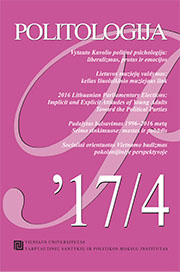Padalytas balsavimas 1996–2016 metų Seimo rinkimuose: Mastas ir pobūdis
Split-Ticket Voting in the Seimas Elections (1996–2016): Extent and Patterns
Author(s): Vaidas MorkevičiusSubject(s): Constitutional Law, Government/Political systems, Electoral systems, Transformation Period (1990 - 2010), Present Times (2010 - today)
Published by: Vilniaus universiteto leidykla & VU Tarptautinių santykių ir politikos mokslų institutas
Summary/Abstract: This article explores the phenomenon of split-ticket voting in the Lithuanian parliamentary elections. The mixed parallel electoral system, introduced into the Seimas elections with the adoption of the Constitution, is a rather favorable institutional structure for split-ticket voting behavior, as citizens are able to vote for a list of candidates of one party in the proportional constituency and for a candidate of another party in the majoritarian single-member constituency. For the analysis of the extent and patterns of split-ticket voting, we have used data from post-election surveys in 2012 and 2016 as well as the aggregate (on the constituency level) data from election results in 1996–2012. An analysis of the aggregate data was performed by employing Søren R. Thomsen’s (1987) estimator for the ecological inference, which allows to estimate the values of internal cells in the R × C tables when only marginal distributions are available. The results of the analysis revealed several important insights about electoral behavior and party competition in Lithuania. The mixed parallel electoral system is not only a theoretically, but also a practically favorable institutional setting for split-ticket voting in Lithuania. An analysis of both the post-election survey data (although to a lesser extent) and the aggregate electoral results showed that the extent of split-ticket-voting in Lithuanian parliamentary elections is rather high. In such cases, sympathizers of the major parties or their candidates choose rather freely from the “menu” offered in single- and multi-member constituencies. Therefore, in this respect, Lithuania is a rather typical Central and Eastern European country, where electoral behavior is rather unconstrained and volatile. An analysis of the aggregate data showed (however, this result was not fully corroborated by the analysis of the post-election survey data) that although split-ticket voting is substantial, its patterns are quite predictably structured by the dimensions of the party competition, which emerged around 2004. Voters split their votes along the lines of certain party blocks. One of these blocks usually contains conservatives and liberals, the other being made up of social democrats, laborites (also the former New Union) and the Order and Justice Party. The latter block might also include the Lithuanian Farmers and Greens Union, even though in the last parliamentary elections, this party attracted a substantial number of votes from sympathizers of different other parties in cases of split-ticket voting. Moreover, an analysis of the aggregate data revealed another interesting pattern of split-ticket voting in Lithuania. In the parliamentary elections of 2008, 2012 and 2016, the newly emerging relevant parties (the National Resurrection Party, The Way of Courage and the Lithuanian Farmers and Greens Union) collected a substantial part of their votes (in cases of split-ticket voting) from the oldest and longest-established parties in Lithuania: The Homeland Union – Lithuanian Christian Democrats and the Lithuanian Social Democratic Party. This pattern of electoral behavior might be explained by the protest voting on the side of the supporters of these two parties. Thus, an analysis of split-ticket voting patterns revealed quite an interesting phenomenon – split-ticket voting as a variation of protest voting – which could become an object of further investigations.
Journal: Politologija
- Issue Year: 2017
- Issue No: 4 (88)
- Page Range: 105-141
- Page Count: 37
- Language: Lithuanian

